
Workers in the Changing Indian Economy - Challenges Ahead
Versandkostenfrei!
Versandfertig in 6-10 Tagen
53,99 €
inkl. MwSt.

PAYBACK Punkte
27 °P sammeln!
This comparative study of the organised and unorganised sector workers seeks to place emphasis on the latter since earlier studies have focused on the former and neglected the latter. In view of the economic recession, we would be discussing Social Risk Management, a new conceptual framework for social protection (Holzmann and Jorgensen, 2000). Women workers will also be the focus of this study in the changing economic scenario since a large number of workers working in these industries are women.There are 58 million enterprises in India providing employment to 104 million workers. They contri...
This comparative study of the organised and unorganised sector workers seeks to place emphasis on the latter since earlier studies have focused on the former and neglected the latter. In view of the economic recession, we would be discussing Social Risk Management, a new conceptual framework for social protection (Holzmann and Jorgensen, 2000). Women workers will also be the focus of this study in the changing economic scenario since a large number of workers working in these industries are women.There are 58 million enterprises in India providing employment to 104 million workers. They contribute to 31% of GDP. The unorganised sector in India comprises about 92% of the working population, and this sector makes significant contributions to national wealth, yet workers in this sector have not received attention, especially from sociologists.














